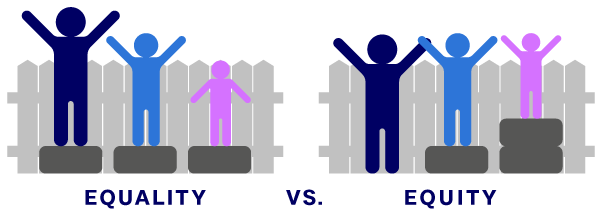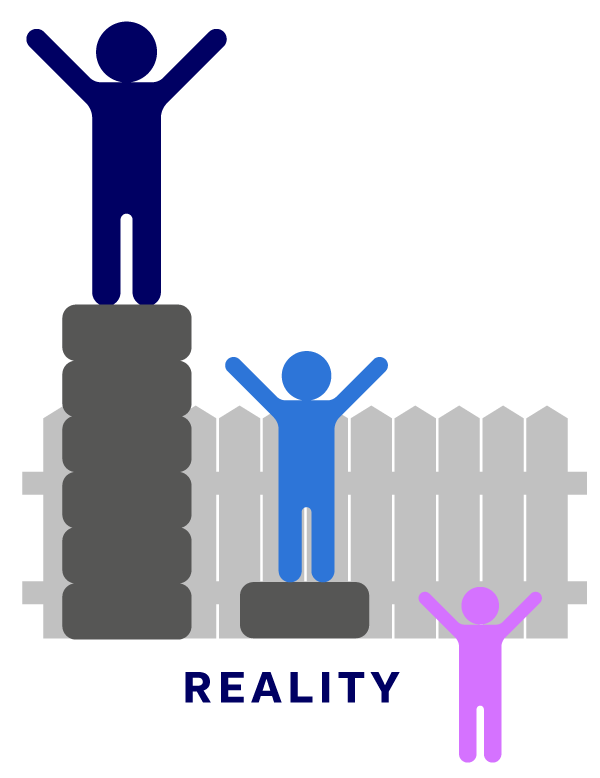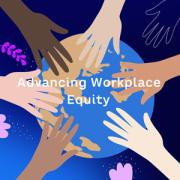AMPLIFY VOL. 36, NO. 2

The definition of equity — justice according to natural law or right, along with freedom from bias or favoritism — seems straightforward. Yet people still experience countless acts of inequity daily. We see this in many ways, including reports from the US Bureau of Labor Statistics showing much lower job growth for people of color. Among major worker groups, Black and Latinx workers have a larger percentage of joblessness compared to their white counterparts.1
How can this be the case when so many corporations strive to create equality in the workplace? Here’s the problem: equality is not the same as equity.
An article published by George Washington University, “Equity vs. Equality: What’s the Difference?” offers this explanation:
While the terms equity and equality may sound similar, the implementation of one versus the other can lead to dramatically different outcomes for marginalized people. Equality means each individual or group of people is given the same resources or opportunities. Equity recognizes that each person has different circumstances and allocates the exact resources and opportunities needed to reach an equal outcome.2
Let’s think about this with a visual example. The left side of Figure 1 shows each person being given one box; they are being treated equally. Of course, everyone has unique characteristics and needs. Clearly, the person offering the boxes didn’t take height disparities into consideration. The person who is tall doesn’t really need a box, while the shortest person requires multiple boxes (see right side of Figure 1). Taken a step further, a disabled person couldn’t use a box at all. He or she might benefit from a ramp.

Have you experienced these types of situations in your everyday life, or place of employment? I’m a woman of color with more than 35 years’ experience in technology inside corporate America, but I still find myself having to speak loudly and ask for considerations to create an equitable career path. Many times, I’ve felt like the purple person in Figure 2. As that illustration helps explain, one person has an enormous advantage, including access to items to make the task at hand easier. Contrast that with the individual who doesn’t start off on an even footing. This is the reality many people of color experience as they pursue technology (and other) careers, strive for career advancement, and aspire to executive-level positions.

The first step in addressing corporate inequities is a reality assessment. What inequities exist within your company’s culture, norms, and practices? Only with that understanding can your company build a strategy to move everyone toward equitable processes.
Knowing is not enough; we must apply. Being willing is not enough; we must do.
— Johann Wolfgang von Goethe, German writer and statesman
Speaking of doing, each March, we celebrate Women’s History Month, and during that time I pause to acknowledge the vast number of women who have successfully blazed trails. We have designated a month to highlight their accomplishments and thank them for the doors they have opened, the ceilings they have shattered, and the sacrifices they have made so that the next generation has “easier” experiences.
It is my hope that by next year’s Women’s History Month, we will see measurable differences in the percentages of women of color in entry-level through executive-level positions in the technology industry, as well as across the corporate world.
In This Issue
This issue of Amplify contains six articles written by executives, researchers, and professionals with vast experience and knowledge on the topic of equity versus equality. The first two articles provide global perspectives on diversity, equity, and inclusion (DEI). The third contains cutting-edge research that shows the reality of equity in many companies. The final three pieces describe best practices that companies have deployed to create a more equitable on-ramp as well as advancement opportunities for all employees, with a focus on women of color.
The first global perspective article is by DEI consultant Rohini Anand. She explains that a “willingness to expose oneself to experiences outside one’s home country to truly understand local cultures and geopolitical contexts without judgement” is at the core of global DEI competency.
This type of exploration, according to Anand, encourages us to look inward, sharpen self-awareness and cultivate a global mindset. By doing this, we can be authentically curious about other cultures and continuously learn. Anand also encourages us to be strategic about integrating that global mindset and intellectual curiosity into our work.
This exploration and understanding should not only occur in the offices we visit abroad, but within our home countries as well. The US, in particular, is a melting pot of cultures, experiences, and ethnicities, so companies should implement this framework across the enterprise, encouraging employees to explore and understand their fellow coworkers.
Our second global perspective article comes from David S. Lee who “offers an on-the-ground perspective of how diversity policies encounter issues once they leave home shores.” He examines the construction of diversity policies along with relocation issues that come up and provides ways to enhance diversity policies in a more holistic way that considers cultural contexts.
Next, Matthew Walsh explores the results of in-depth research conducted to identify the inequities that women of color experience in the technology industry. Walsh specializes in workforce development projects and “how to create and connect people to good jobs that support individuals, families, and communities.”
Walsh begins his piece by pointing out the “occupational segregation” that exists in the workplace with the underrepresentation of Black, Latino, and American Indian women in fast-growing sectors. To help mitigate this concern, Walsh offers the Equation for Equality, a tool employers can use “to expand their talent pool in a low-risk way by identifying workers outside a given sector who use a similar skill set to the one required by an open position.” By going beyond the traditional elements of sector experience, education, or firm history, “the equation helps employers identify good employment matches based on skills.”
Our final three articles explain how organizations are addressing equity in the workplace. We start with Timicka Anderson and Philip Fitzgerald who highlight why diversity is both a strength and a priority at Citibank, a global bank committed to DEI as a core value with “the belief that transparency and accountability are key to success.”
Anderson and Fitzgerald note that in spite of the contributions women of color make to the US economy when gainfully employed, they continue to have limited access on their career journeys. As the authors assert, “Technology jobs are one of the most prominent examples of this gap: only 5% of the tech workforce are women of color.” The authors then explain the impact to the bottom line when companies increase access to nontraditional ways to pursue careers, rather than relying on traditional pathways. Anderson and Fitzgerald emphasize that “upskilling, the practice of facilitating continuous learning by providing training programs and development opportunities that expand an individual’s abilities, is key.” That’s why Citi supports NPower’s work in building a diverse technology workforce “through clear pathways for people of all ethnicities, genders, and socioeconomic backgrounds,” with a particular emphasis on women of color.
Our second workplace article is by Eli Doster, an 18-year veteran of the staffing industry who “believes deeply in the power of culture and always putting people first.” Doster shares that having a broken culture was not only terrible for staff at his company, Insight Global, it was also costly and had a negative impact on business. Five years ago, the company lacked values employees could believe in, which affected their decisions and actions. Furthermore, the company lacked “diversity of cultures, ethnicity, and perspective.”
Doster talks about the signals that enabled its leaders to identify these problems and describes how they implemented the changes that transformed the culture and improved their overall results. He also shares how Insight Global’s work in under-resourced communities is closing the gap on “social inequities, economic inequalities, and disenfranchisement” experiences that pose “serious challenges for people [of color] seeking to enter the workforce or advance their careers.”
Our final article is from Linda A. Patterson who begins by talking about the strength that women of color possess that “stems from endurance, perseverance, and survivorship.” Given their many roles in the workplace, home, and community, women of color excel at managing, creating, innovating, strategizing, and multitasking. These skills are often additive to their formal education and specializations.
So why aren’t they being given an equitable seat at the table? Why do we still have low percentages of women of color in technology jobs, senior-level positions, and board roles? Patterson suggests five steps toward offering “equitable opportunities for women of color in a meaningful, sustainable, and measurable way.”
As you read this issue of Amplify, be intentional about how you use this information. The best practices shared in our first two articles can be a meaningful starting point for companies that are already global and those planning to expand into the global marketplace. The startling statistics in Walsh’s article are intended to raise your awareness and, perhaps, incite you to take action. The vulnerabilities shared by our featured companies and individuals are designed to encourage you to take that first step — or to start over after stalling or failing.
The most difficult thing is the decision to act, the rest is merely tenacity.
— Amelia Earhart, US aviator
References
1 “Employment Situation Survey.” US Bureau of Labor Statistics, 10 March 2023.
2 “Equity vs. Equality: What’s the Difference?” Milken Institute School of Public Health, The George Washington University, 5 November 2020.



